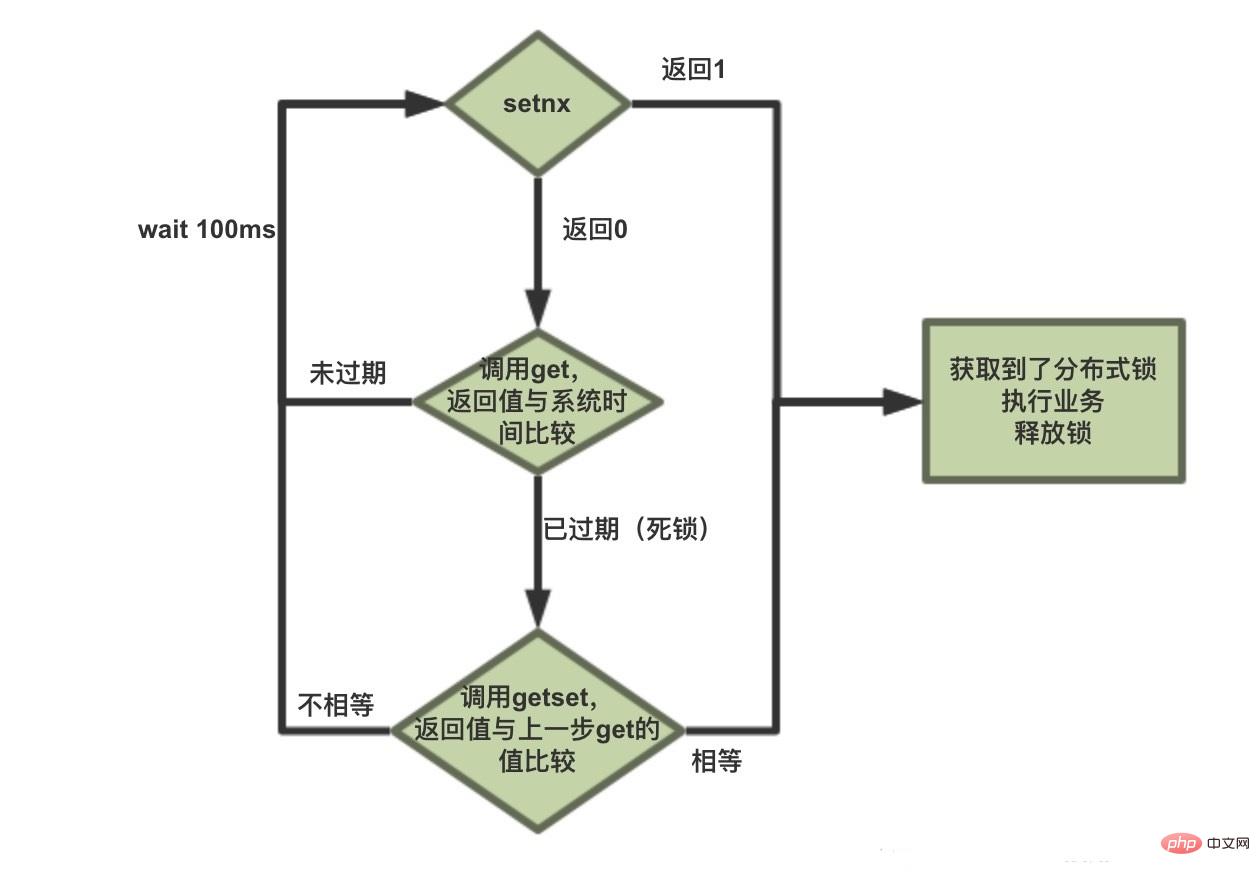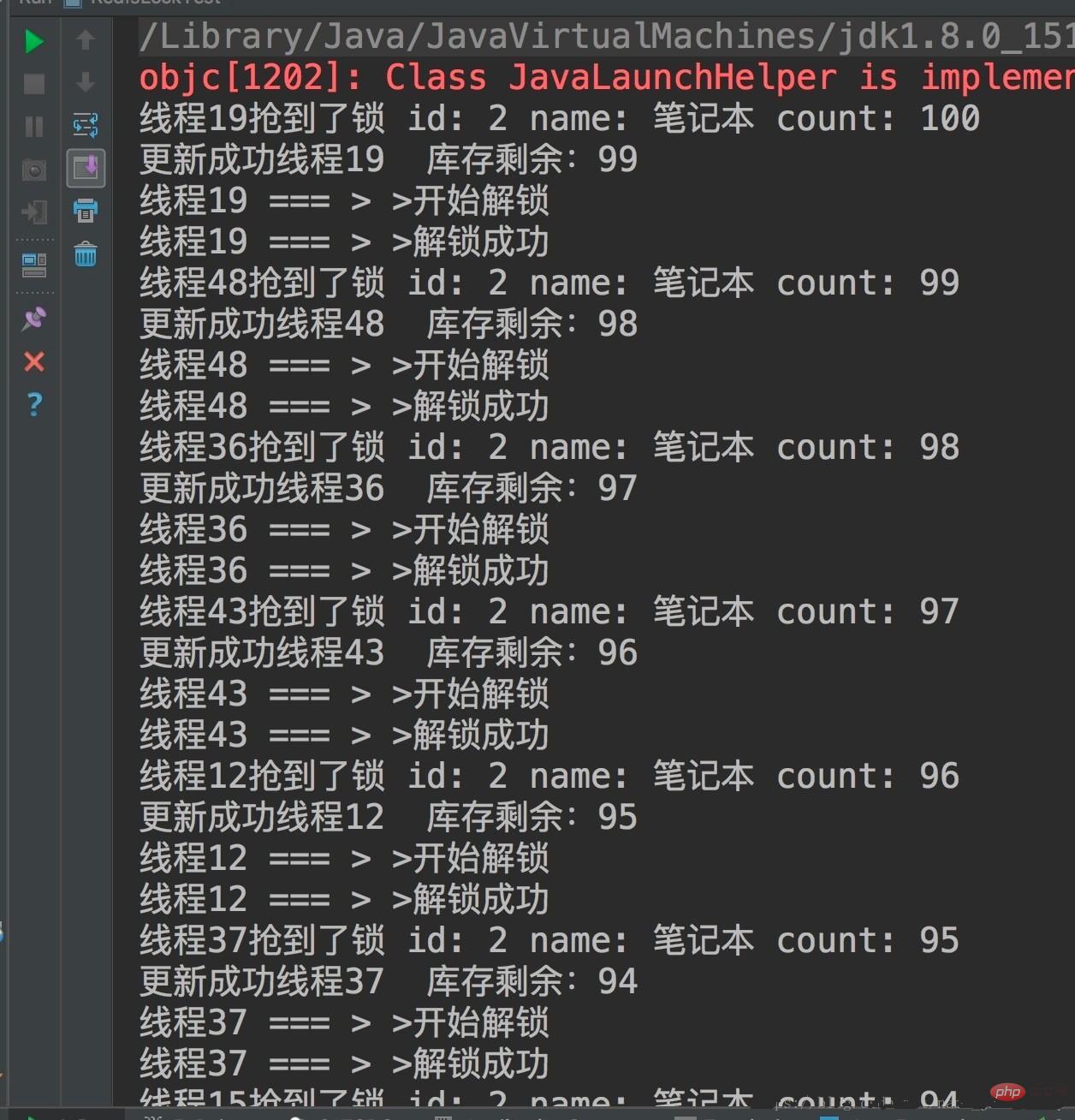
分布式锁,是控制分布式系统之间同步访问共享资源的一种方式。
在分布式系统中,常常需要协调他们的动作。如果不同的系统或是同一个系统的不同主机之间共享了一个或一组资源,那么访问这些资源的时候,往往需要互斥来防止彼此干扰来保证一致性,在这种情况下,便需要使用到分布式锁。
使用setnx、getset、expire、del这4个redis命令实现 (推荐学习:Redis视频教程)
setnx 是『SET if Not eXists』(如果不存在,则 SET)的简写。 命令格式:SETNX key value;使用:只在键 key 不存在的情况下,将键 key 的值设置为 value 。若键 key 已经存在, 则 SETNX 命令不做任何动作。返回值:命令在设置成功时返回 1 ,设置失败时返回 0 。
getset 命令格式:GETSET key value,将键 key 的值设为 value ,并返回键 key 在被设置之前的旧的value。返回值:如果键 key 没有旧值, 也即是说, 键 key 在被设置之前并不存在, 那么命令返回 nil 。当键 key 存在但不是字符串类型时,命令返回一个错误。
expire 命令格式:EXPIRE key seconds,使用:为给定 key 设置生存时间,当 key 过期时(生存时间为 0 ),它会被自动删除。返回值:设置成功返回 1 。 当 key 不存在或者不能为 key 设置生存时间时(比如在低于 2.1.3 版本的 Redis 中你尝试更新 key 的生存时间),返回 0 。
del 命令格式:DEL key [key …],使用:删除给定的一个或多个 key ,不存在的 key 会被忽略。返回值:被删除 key 的数量。
Redis实现分布式锁的原理:
1.通过setnx(lock_timeout)实现,如果设置了锁返回1, 已经有值没有设置成功返回0
2.死锁问题:通过实践来判断是否过期,如果已经过期,获取到过期时间get(lockKey),然后getset(lock_timeout)判断是否和get相同,相同则证明已经加锁成功,因为可能导致多线程同时执行getset(lock_timeout)方法,这可能导致多线程都只需getset后,对于判断加锁成功的线程, 再加expire(lockKey, LOCK_TIMEOUT, TimeUnit.MILLISECONDS)过期时间,防止多个线程同时叠加时间,导致锁时效时间翻倍
 代码:
代码:
/**
* @author yaoxin
* @date 2018/8/13下午5:04
*/
public class RedisLockTest {
public static final String url = "jdbc:mysql://127.0.0.1:3306/ly?characterEncoding=UTF-8";
public static final String name = "com.mysql.jdbc.Driver";
public static final String user = "root";
public static final String password = "";
public static void main(String[] args) {
Integer count = 50;
while (count > 0) {
count--;
new Thread(new Runnable() {
@Override
public void run() {
Jedis jedis = new Jedis("127.0.0.1", 6379);
jedis.auth("1234");
String lock = lock(jedis);
if (lock != null) {
Statement statement = null;
Connection conn = null;
ResultSet resultSet = null;
try {
Class.forName(name);// 指定连接类型
conn = DriverManager.getConnection(url, user, password);// 获取连接
statement = conn.createStatement();// 准备执行语句
String querySql = "SELECT id,name,count FROM production WHERE id=2";
resultSet = statement.executeQuery(querySql);
int count = 0;
while (resultSet.next()) {
System.out.println(Thread.currentThread().getName() + "抢到了锁 id: " + resultSet.getString("id")
+ " name: " + resultSet.getString("name")
+ " count: " + resultSet.getString("count"));
count = Integer.valueOf(resultSet.getString("count"));
}
String updateSql = "UPDATE production SET count=" + (count - 1)
+ " WHERE id=2";
int rows = statement.executeUpdate(updateSql);
if (rows > 0) {
System.out.println("更新成功" + Thread.currentThread().getName() + " 库存剩余:" + (count - 1));
System.out.println(Thread.currentThread().getName() + " === > >开始解锁");
boolean unlock = unlock(jedis, lock);
if (unlock)
System.out.println(Thread.currentThread().getName() + " === > >解锁成功");
} else {
System.out.println("更新失败" + Thread.currentThread().getName());
}
} catch (Exception e) {
e.printStackTrace();
} finally {
try {
if (conn != null)
conn.close();
if (statement != null)
statement.close();
if (resultSet != null)
resultSet.close();
} catch (Exception e) {
e.printStackTrace();
}
}
}
}
}, "线程" + count).start();
}
}
public static String lock(Jedis jedis) {
try {
while (true) {
String lockTime = Long.valueOf(jedis.time().get(0)) + 5 + "";
if (jedis.setnx("lock", lockTime) == 1) {
jedis.expire("lock", 5);
return lockTime;
}
String lock = jedis.get("lock");
if (!StringUtils.isEmpty(lock) && Long.valueOf(lock) < Long.valueOf(jedis.time().get(0))) {
String oldLockTime = jedis.getSet("lock", lockTime);
if (!StringUtils.isEmpty(oldLockTime) && oldLockTime.equals(lock)) {
return lockTime;
}
}
Thread.sleep(100);
}
} catch (Exception e) {
e.printStackTrace();
}
return null;
}
public static boolean unlock(Jedis jedis, String lockTag) {
if (lockTag.equals(jedis.get("lock"))) {
jedis.del("lock");
return true;
}
return false;
}
}运行结果如下图:

更多Redis相关技术文章,请访问Redis入门教程栏目进行学习!
以上是redis分布式锁如何实现原理的详细内容。更多信息请关注PHP中文网其他相关文章!
 REDIS与SQL数据库:关键差异Apr 25, 2025 am 12:02 AM
REDIS与SQL数据库:关键差异Apr 25, 2025 am 12:02 AMRedis和SQL数据库的主要区别在于:Redis是内存数据库,适用于高性能和灵活性需求;SQL数据库是关系型数据库,适用于复杂查询和数据一致性需求。具体来说,1)Redis提供高速数据访问和缓存服务,支持多种数据类型,适用于缓存和实时数据处理;2)SQL数据库通过表格结构管理数据,支持复杂查询和事务处理,适用于电商和金融系统等需要数据一致性的场景。
 REDIS:它如何充当数据存储和服务Apr 24, 2025 am 12:08 AM
REDIS:它如何充当数据存储和服务Apr 24, 2025 am 12:08 AMREDISACTSASBOTHADATASTOREANDASERVICE.1)ASADATASTORE,ITUSESIN-MEMORYSTOOGATOFORFOFFASTESITION,支持VariousDatharptructuresLikeKey-valuepairsandsortedsetsetsetsetsetsetsets.2)asaservice,ItprovidespunctionslikeItionitionslikepunikeLikePublikePublikePlikePlikePlikeAndluikeAndluAascriptingiationsmpleplepleclexplectiations
 REDIS与其他数据库:比较分析Apr 23, 2025 am 12:16 AM
REDIS与其他数据库:比较分析Apr 23, 2025 am 12:16 AMRedis与其他数据库相比,具有以下独特优势:1)速度极快,读写操作通常在微秒级别;2)支持丰富的数据结构和操作;3)灵活的使用场景,如缓存、计数器和发布订阅。选择Redis还是其他数据库需根据具体需求和场景,Redis在高性能、低延迟应用中表现出色。
 REDIS的角色:探索数据存储和管理功能Apr 22, 2025 am 12:10 AM
REDIS的角色:探索数据存储和管理功能Apr 22, 2025 am 12:10 AMRedis在数据存储和管理中扮演着关键角色,通过其多种数据结构和持久化机制成为现代应用的核心。1)Redis支持字符串、列表、集合、有序集合和哈希表等数据结构,适用于缓存和复杂业务逻辑。2)通过RDB和AOF两种持久化方式,Redis确保数据的可靠存储和快速恢复。
 REDIS:了解NOSQL概念Apr 21, 2025 am 12:04 AM
REDIS:了解NOSQL概念Apr 21, 2025 am 12:04 AMRedis是一种NoSQL数据库,适用于大规模数据的高效存储和访问。1.Redis是开源的内存数据结构存储系统,支持多种数据结构。2.它提供极快的读写速度,适合缓存、会话管理等。3.Redis支持持久化,通过RDB和AOF方式确保数据安全。4.使用示例包括基本的键值对操作和高级的集合去重功能。5.常见错误包括连接问题、数据类型不匹配和内存溢出,需注意调试。6.性能优化建议包括选择合适的数据结构和设置内存淘汰策略。
 REDIS:现实世界的用例和示例Apr 20, 2025 am 12:06 AM
REDIS:现实世界的用例和示例Apr 20, 2025 am 12:06 AMRedis在现实世界中的应用包括:1.作为缓存系统加速数据库查询,2.存储Web应用的会话数据,3.实现实时排行榜,4.作为消息队列简化消息传递。Redis的多功能性和高性能使其在这些场景中大放异彩。
 REDIS:探索其功能和功能Apr 19, 2025 am 12:04 AM
REDIS:探索其功能和功能Apr 19, 2025 am 12:04 AMRedis脱颖而出是因为其高速、多功能性和丰富的数据结构。1)Redis支持字符串、列表、集合、散列和有序集合等数据结构。2)它通过内存存储数据,支持RDB和AOF持久化。3)从Redis6.0开始引入多线程处理I/O操作,提升了高并发场景下的性能。
 Redis是SQL还是NOSQL数据库?答案解释了Apr 18, 2025 am 12:11 AM
Redis是SQL还是NOSQL数据库?答案解释了Apr 18, 2025 am 12:11 AMRedisisclassifiedasaNoSQLdatabasebecauseitusesakey-valuedatamodelinsteadofthetraditionalrelationaldatabasemodel.Itoffersspeedandflexibility,makingitidealforreal-timeapplicationsandcaching,butitmaynotbesuitableforscenariosrequiringstrictdataintegrityo


热AI工具

Undresser.AI Undress
人工智能驱动的应用程序,用于创建逼真的裸体照片

AI Clothes Remover
用于从照片中去除衣服的在线人工智能工具。

Undress AI Tool
免费脱衣服图片

Clothoff.io
AI脱衣机

Video Face Swap
使用我们完全免费的人工智能换脸工具轻松在任何视频中换脸!

热门文章

热工具

SublimeText3 英文版
推荐:为Win版本,支持代码提示!

ZendStudio 13.5.1 Mac
功能强大的PHP集成开发环境

MinGW - 适用于 Windows 的极简 GNU
这个项目正在迁移到osdn.net/projects/mingw的过程中,你可以继续在那里关注我们。MinGW:GNU编译器集合(GCC)的本地Windows移植版本,可自由分发的导入库和用于构建本地Windows应用程序的头文件;包括对MSVC运行时的扩展,以支持C99功能。MinGW的所有软件都可以在64位Windows平台上运行。

适用于 Eclipse 的 SAP NetWeaver 服务器适配器
将Eclipse与SAP NetWeaver应用服务器集成。

Atom编辑器mac版下载
最流行的的开源编辑器





